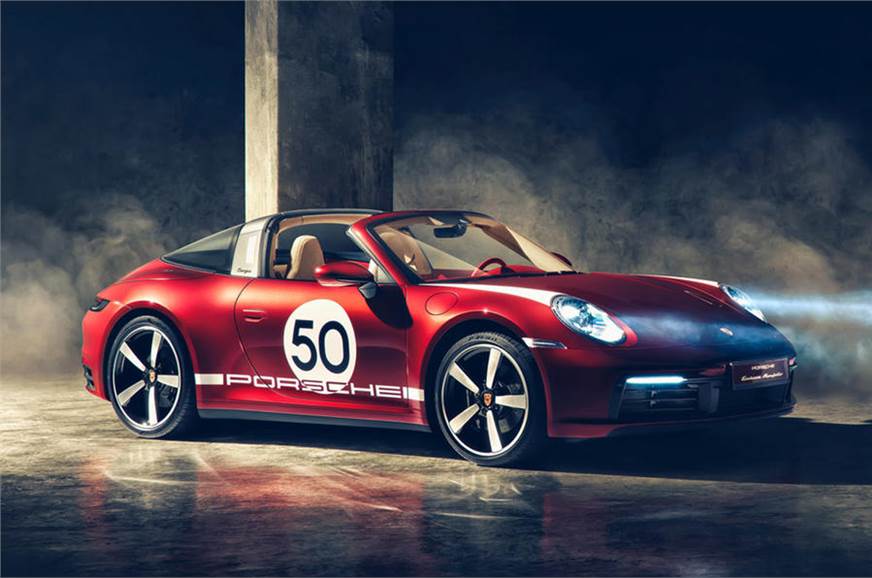Porsche 911 Targa 4S Heritage Design revealed

-
The Porsche 911 Targa 4S Heritage Design is the first of four classic-led limited edition models
-
Limited run of 992 units
-
Designs hark back to Porsches from the 1950s; Heritage pack will be available for standard 911s too
Porsche’s new 911 Targa 4S Heritage Design, which has just been revealed, is the first of four classic-led special editions. The model marks the beginning of expansion plans for Porsche’s bespoke arm, Porsche Exclusive Manufaktur.
The other three special editions will be revealed over the course of the 992-generation 911’s lifetime. They will appear on different 911 variants and celebrate different decades in the 911’s history. The limited-run models are intended to blend the technology of modern-day 911s with design elements from the past.
The idea was first launched last year on the limited-edition 911 Speedster Heritage Design. Porsche Exclusive Manufaktur director Boris Apenbrink said: “The Speedster Heritage Design concept was a prequel which tested out how the design features work on Porsche fans and customers.”
As the first Heritage Design production model, the Targa 4S was chosen because it is “the most emotional derivative in the 911 range”, said Apenbrink. “Everyone recognises a Targa at first glance, so we decided this was the best basis for the first Heritage Design model.”
Limited to 992 units – reflecting the eighth-generation 911’s internal designation – the Heritage Design model costs GBP 1,36,643 (about Rs 1.29 crore) – GBP 26,918 (approx. Rs 25.41 lakh) more than a standard Targa 4S on sale in the UK. Order books open today in that market, with the first deliveries set to take place in the autumn (September-October). Technical specifications, including a 0-100kph time of 3.6sec, remain unchanged from the standard 911 Targa 4S.
The model harks back to details of the 1950s and 1960s, led by exclusive Cherry Red paint, which was inspired by the early shades of the 356. The Porsche logo returns the word 'Porsche' to its old font, while the brake calipers are black. “In the ’50s, we didn’t have red or yellow ones,” says Apenbrink.
There is historical white livery, including lollipop stickers on the doors on which customers can specify numbers, and gold trim parts as they once were. Porsche has also reintroduced a badge on the rear lid, inspired by those given to 356 owners who reached 1,00,000km in their cars.
“We took that design and made it a bit more modern but easily recognisable for fans,” said Apenbrink.
Inside, the Heritage Design's standout details are red leather and corduroy seats, both of which were used in the 356, as well as the white indicators and sport chronograph known from classic Porsches.
Talking about the rollout of more models from the bespoke division, Apenbrink said: “It will be up to two years before you can expect the next car. We don’t want to overdo it. Porsche Exclusive stands for passion and craftsmanship. We want enthusiasts to say: ‘They’ve nailed it, that car has everything that is truly iconic for the ’50s’.
“This first one reflects the ’50s and ’60s, while upcoming ones will cover the ’60s, ’70s and ’80s. We started on the Targa, and the other three limited editions will be based on other 911 variants.”
Talking about potential buyers for the cars, Apenbrink said: “These special editions are not in competition with electrification or connectivity features but an addition. We have a lot of customers who are fascinated by classic design features and want to see them in modern cars. We are known for our rich heritage. But it might also inspire people who have not considered Porsche before to think: ‘This is a cool style that brings back something from the past'.”
North America is expected to account for a third of sales, Europe half of sales and the rest spread, worldwide. Apenbrink explained: “There’s not much interest from the Chinese market, because people are more focused on modern times than knowing the past of Porsches. It’s for those countries where we have many fans that know Porsche heritage.”
He also acknowledged the business sense of the bespoke arm. “Our investment in the future with electrification is very expensive, so it makes sense that everything Porsche does needs to be profitable, such as projects like these. From a business standpoint, these [projects] are very attractive, so it’s a clear win-win: it attracts customers and helps keep the business alive.”
Alongside the special editions, an unlimited Heritage Design pack, which adds some of the design features of the fully-fledged versions, will be available across the 911 range. “The strategy will always consist of limited-edition models and packages available for other 911 model types. That means we can strengthen exclusivity of the [Exclusive] brand but still get exposure to it on the roads,” said Apenbrink.
The division will also look beyond heritage-inspired models in future. “We can grow far beyond the heritage area. It makes sense to start on the 911, but we are looking into our other model lines,” added Apenbrink.
He also hinted that a future limited-edition might be offered as manual only. “We are great supporters of manual transmissions, because we think it is where you have the most involvement as a driver. Times are changing, because many people are not used to operating manual transmissions any more. From the heart, the [manual] is still something that no one wants to miss, especially in a Porsche. Maybe there will be another Heritage Design car that will only be offered as a manual transmission. That decision is not made yet, but we would be big fans.”
Also see:
Porsche 911 Targa 4S Heritage Edition image gallery
“I do not believe in an electric 911”: Frank-Steffen Walliser, Porsche 911 product head

No comments
please do not enter any spam link in the comment box